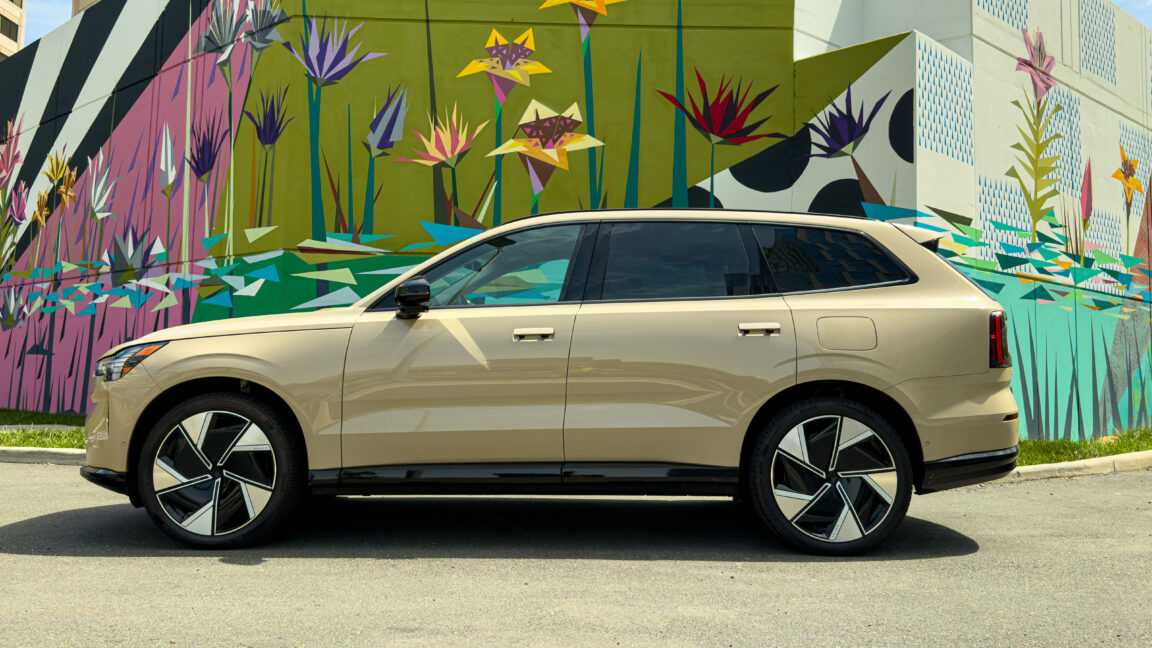
Credit: Jonathan Gitlin
Volvo was among the very first of the global automakers to declare plans to build an all-electrified future. Note the choice of word—electrified, not electric, as it includes hybrids, both plug-in and mild. When it comes to pure electric vehicles, the Swedish automaker has something of a two-pronged strategy. At the low end, there's the diminutive EX30 and EX30 Cross Country, a pair of stripped-down crossovers whose value proposition might be entirely different in light of tariffs and the end of the clean vehicle tax credit. At the other end of the spectrum is the EX90, a big battery electric SUV with tech so cutting-edge that some of it wasn't even ready when we had our first drive last fall.
The idea of a high-end Volvo is not a new one; for decades, the company has offered a low-key luxury alternative to the flashier German brands. It's just that back then, your family doctor probably drove a Volvo station wagon, whereas these days, most people want something with a little more height. Unlike the little EX30s, the EX90 should be largely unaffected by the recent chaos—it's built in South Carolina, so it isn't subject to import tariffs (beyond any imported parts used to build it) and with a starting price of $81,290, it's just too expensive to qualify for the IRS 30D tax credit, which now goes away at the end of September.
Do Volvo's impeccable safety credentials and the EX90's emissions-free powertrain purchase it any credit in the war on cars? Probably not, but there's something wonderfully incongruous about the slab sides and beige paint (actually a solid metallic called Sand Dune) accented by the bright jewelry of the daylight running lights, although the lidar hump on the roof continues to scream "London taxi cab" at me. (Did you know that Volvo's corporate parent also owns a company that builds those?) As you approach the car and it unlocks, the "Thor's Hammer" headlights do a neat little mechanical "blink"—think that one alien that Will Smith chased around the Guggenheim in Men in Black.
Integration of the lidar sensor into Volvo's suite of active safety systems and advanced driver assistance systems was a case of patching it in the field—the sensors were installed but not active when we drove EX90s briefly in September. They're functional now, as some owners have found to their phones' detriment. The lidar's emissions are eye-safe, but they aren't quite as gentle on the sensitive parts of digital cameras, so don't go pointing one at an EX90's lidar hump if that EX90 is turned on.
The lidar is fixed, not like the spinning pucks you might see on one of Waymo's autonomous robotaxis, and it contributes a long-range forward view that the car's computer brain fuses together with input from cameras, radar, and ultrasonic sensors. Volvo's active safety systems can be notoriously overeager to sound the alarm—in the case of crash avoidance, a false positive is generally preferable to a false negative—but this EX90 was one of the more chill Volvos I've driven in that regard. I'm not sure it ever freaked out once when spotting a curb while I was backing into a parking space, unlike some other cars from the brand that I've driven lately.
The exterior vibes might give off school bus or London cab vibes, but from the inside, this big, beige SUV is indeed low-key luxurious, as the kids might say. The base EX90 is already well-equipped, but our test car was the $85,640 Ultra trim, which adds things like air suspension and massaging front seats. I've previously praised Volvo's seat massaging tech, which seems to put other OEMs to shame, and the air suspension benefits the ride, so both are welcome additions.
The Bowers and Wilkins sound system is a separate $3,200 option, and it sounds rather good. The urge to drive around slowly with the windows down and the volume cranked (but with something suitably beige Volvo-ish playing on the sound system) was hard to fight on a warm spring afternoon.
You can also pay $5,000 to increase the EX90's output from the standard twin motor's 402 hp (300 kW) to 510 hp (380 kW). That shaves a second off the 0–60 time (from 5.7 to 4.7 seconds), but the range remains unchanged at 310 miles (498 km) when fitted with 21-inch wheels, or 300 miles (482 km) when fitted with 22-inch wheels. The performance upgrade is probably a box that doesn't need ticking. Modern air suspension can make up for all manner of weight gain, but you're always aware you're driving something big and heavy, even if the rear torque vectoring makes the vehicle rather nimble.
If a sharp-handling electric SUV is what you're looking for, Volvo spinoff Polestar is where your attention should be, not this EX90. This car cries out to be puttered around in, not flogged.
The life of a press fleet vehicle probably involves a lot of flogging, though. A glance at the un-reset trip computer shows that over the last almost-1,400 miles, the EX90 has averaged 2.8 miles/kWh (22.2 kWh/100 km), which is exactly the same as I averaged during that short drive last year. Charging is still via CCS1, with an adapter for NACS. Fast charging tops out at 250 kW, and you can expect to wait about 30 minutes to charge from 10 to 80 percent.
I'm happy to report that our week with the EX90 yielded little in the way of software bugs. They're increasingly common in our tests of new cars, particularly ones like this that fall into the "software defined vehicle" category, where black boxes of legacy cruft have been replaced with clean-sheet code and a handful of high-powered computers. The infotainment UI is simple and responsive and has Google services built in. But you can also just cast an iPhone wirelessly to the portrait-oriented 14.5-inch touchscreen via Apple CarPlay. With just four USB-C ports that top out at just 18 W, the EX90 can't offer road warriors as much in the way of mobile charging as some other three-row EVs we've tested recently.
The third row, like almost all three-row SUVs, is only for occasional use when it comes to adult-sized passengers. With this occasional row folded flat, the luggage capacity almost triples, then doubles again when you fold the middle row down.
The EX90 almost has a niche to itself. There are cheaper three-row EVs available like the Hyundai Ioniq 9, which has much more modern powertrain tech, or the Volkswagen ID. Buzz, which is vast inside and comes with a third row usable by almost anyone. Neither has a badge with quite the cache of Volvo, though. Perhaps the closest alternative is the dual-motor Rivian R1S, which trades the Volvo's dependable obsession with safety for mountain goat agility off-road.

-
 C114 Communication Network
C114 Communication Network -
 Communication Home
Communication Home


